There are some interesting—and noteworthy—trends taking place across the publishing industry. While many of those trends signal change and evolution, others harken back to the genesis of our relationship with written and spoken language.
The last 10 years have been turbulent for publishers, writers, and agents. Technology has spurred seven key trends that are shaping the business and the art of our literary industry.
For publishers, these trends also offer a peek into the future and some insight about what to expect, how to prepare for growth in a shifting landscape, and why the industry can both evolve and stay the same.
1. Independent bookstores are on the rise
One of the most interesting—and unexpected—trends over the last decade is the resurgence of independent bookstores across the U.S.
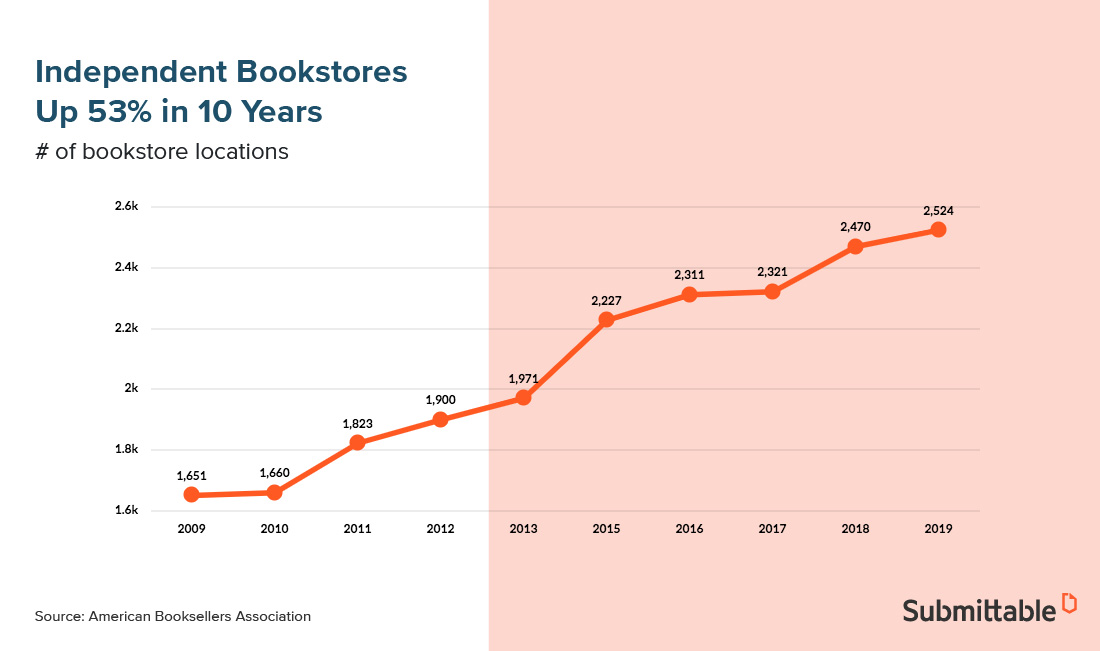
After most mom and pop bookstores were assumed dead in the 1990s with the rise of mega bookstores like Borders and Barnes & Noble, the data now tells a much different story. As we look to 2020, it’s these large retailers that are clinging onto life and smaller, independent bookstores that are undergoing a renaissance.
What this trend means for publishers
While retail may not fully shape business strategy on the publishing side, this surge in corner bookstores is significant.
For one, it may indicate a deeper relationship that many readers have with books. While the mass-market may lean toward convenience and cheaper prices (offered by outlets like Amazon or available through ebooks), a significant segment of readers is still interested in the experience of buying and sharing new works.
Chains rarely offer the experience that these consumers crave.
As broader retail trends demonstrate, consumers are shifting away from generic, big-box stores. Small shops differentiate themselves from online shopping by offering more authentic, human interaction.
Publishers can take advantage of this by investing in relationships and community-building around their titles, targeting independent bookstores as a hub to build deeper connections, as well as brand and author loyalty.
2. Ebooks fell in popularity
When the Kindle first debuted in 2007, it was heralded as a revolution in publishing.
Readers and publishers alike were eager to take advantage of a new platform and digital books took off in a big way. In recent years, the explosive growth of ebooks seems to be flattening out, signaling that digital formats may have plateaued in popularity.

According to a Pew Research Center report, only 25% of U.S. adults read an ebook in the last year. That number is actually down from peaks at 28% in 2014 and 2016. That shift seems to be tied in with other changes to the way that consumers are finding, buying, and reading content, such as the emergence of the audiobook market.
What this trend means for publishers
As with most technology trends, ebook adoption has likely conformed to a wave pattern — rapid growth in popularity, a towering peak, and then a decline to an eventual stasis much lower than the highest point.
We may have already hit the peak of the ebook’s wave.
It could be that the convenience of ebooks and digital formats have a natural limit.
Some segments of readers may simply never be interested in reading on Kindles or other e-readers, instead defaulting back to paperback and hardcover copies.
https://www.youtube.com/watch?v=RpQWumTNvQc&t=2s
In order to maintain growth, ebooks would need to both attract new readers and also maintain their popularity with existing users. This decline could point to the fact that some ebook adopters defected to audio formats.
While ebooks are likely to remain a steady revenue stream, publishers should approach this technology with reasonable expectations. There’s probably no scenario where digital copies catch up with print books—at least not without some other technological innovation that changes consumer habits in a different way.
3. Audiobooks are poised to overtake ebooks
Much like with ebooks, audiobooks have greatly influenced the publishing landscape in the last decade.

With the popularity of music streaming and podcasts, recorded books have also seen a lift. In just the last 4 years, the percentage of adults listening to titles has nearly doubled and the trend seems to be on an upward trajectory.
Since nearly all consumers carry a smartphone in their pocket now, it’s not surprising that we are using those devices to consume a variety of media through audio.
What this trend means for publishers
Looking at similar trends in ebooks, we can and should assume that audiobooks are likely to hit a natural ceiling in the coming years. While they may continue to grow, only a certain segment of book lovers are likely to take up audiobooks as a long term alternative to physical copies.
The new reality for publishers will be a fragmentation of the market—and of sales.
Publishers are under financial and operational pressure to maintain multiple streams of revenue and manage their titles across an array of formats and channels.
Like the emergence of headless CMS for digital content management, technology may eventually emerge to help publishers manage their broadening sales and marketing operations, measure and track key segments, and optimize their overall portfolio to maximize revenue. Current cutting edge tools are useful, but not comprehensive.
4. Novels and short stories lose some steam
One potentially disturbing trend for the literary world is the recent decline in adults reading novels and short stories.
a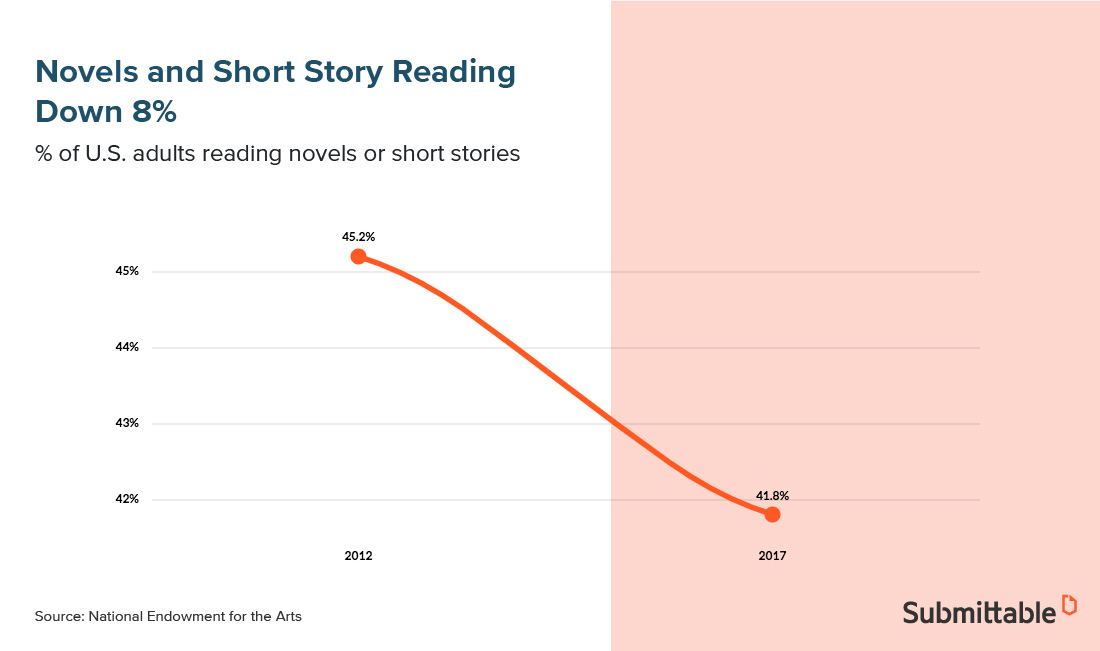
This slide could signal shifts in the industry, but it’s likely too early to draw conclusions. While data from the National Endowment for the Arts shows a three point slide in popularity, which they deem statistically significant, the fall from 45% to just below 42% (in the last 15 years) feels like a slow, steady decline that could reverse course if a few hot titles really hit the mainstream in the coming years.
Nevertheless, publishers shouldn’t ignore changing consumer tastes.
What this trend means for publishers
Coupled with inflated revenues from nonfiction titles (trend #6), there is one question that springs to mind based on this data.
Is reading for pleasure losing its popularity?
It wouldn’t be entirely surprising to learn that fiction and poetry titles have suffered over recent years with the emergence, prevalence, and explosion of on-demand video content. Streaming services like Netflix, Hulu, and HBO Go now take up an estimated 5 hours of the average American’s day.
Luckily, that statistic isn’t all doom and gloom for imprints. Much of the video content being produced is based on literary work adapted for video formats. This could become an increasingly large revenue opportunity for publishers who expand into “omnichannel” content and position their strategy around publishing and licensing stories that are well-suited for streaming video.
The emergence of other digital formats and the increasing overlap in media could inspire some interesting shifts in the coming years.
5. Poetry returns to previous popularity
Among U.S. adults, just over 10% said in 2017 that they had read poetry in the last 12 months.
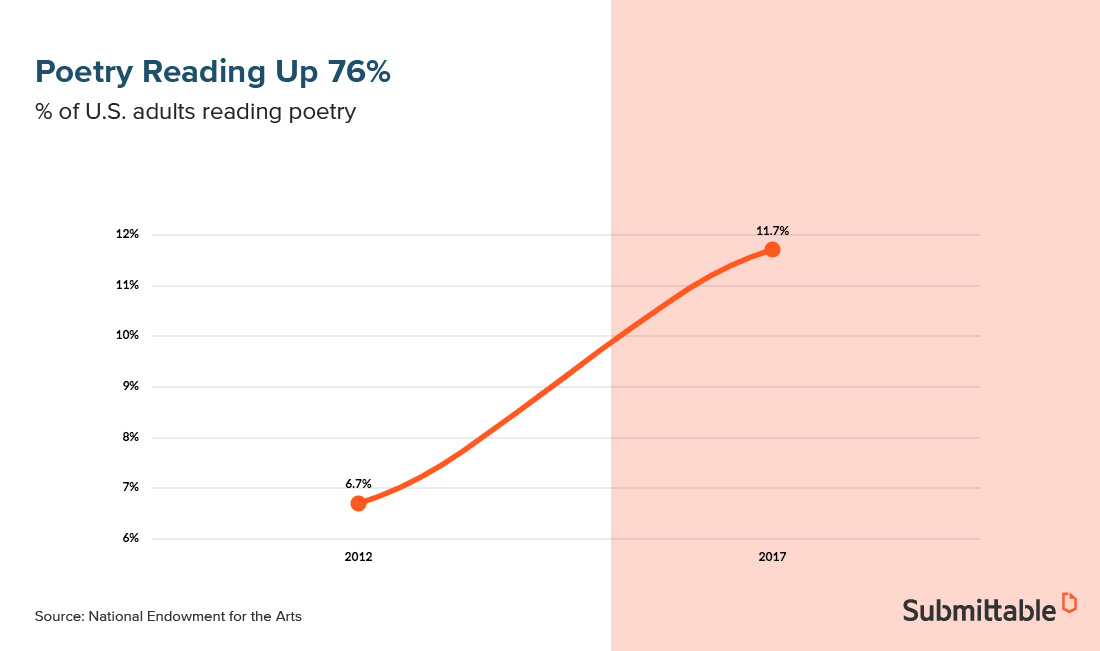
Social media seems to be a catalyst here. Several reports indicate that there’s an emerging market for writers—especially among people of color and marginalized groups—that’s taken shape on Twitter, Instagram, and other networks.
Poetry is a genre du jour among these communities.
This number—while still a fairly small portion of the population—marks a return for poetry reading, which fell by nearly 50% between 2002 and 2012, according to the NEA’s report.
With poetry remaining a fairly small segment but growing in popularity, how will publishers respond?
What this trend means for publishers
Trends like this one could mark an emerging demand for short-form written content. It could also point to new market opportunities of previously-underserved readers.
While other narrative works move to long-form movie and series format, we could see poetry grow in popularity as a decidedly written format that offers a unique experience from novels and Netflix shows.
If this does happen, publishers may note a renewed interest in collections of work, including poetry, flash, short stories, and other formats—literature that can be consumed in a single, short sitting. Perhaps while waiting for the next episode to auto-play?
6. Nonfiction titles blow past fiction
As novels and short stories have seen waning popularity, another genre has gained steam—more than making up for the decline in fiction book sales.
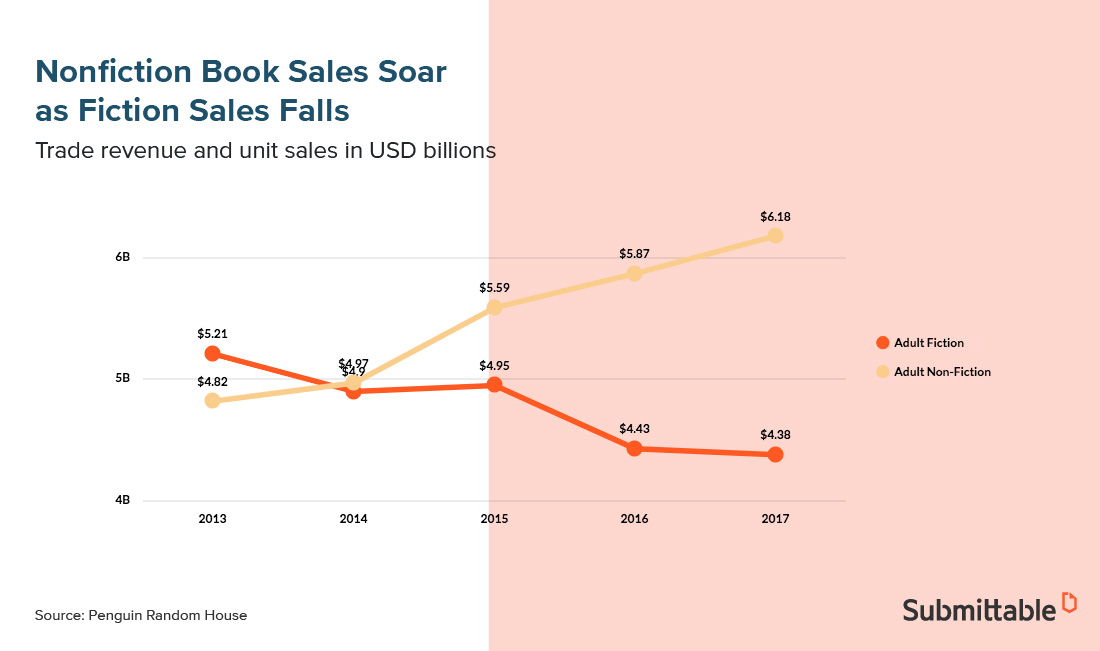
Over the past 5 years, revenue from nonfiction titles has soared by nearly 30%.
According to sales data from Penguin Random House, revenue from adult nonfiction in 2017 was almost 35% larger than the revenue generated by fiction titles. This shift in preference may be a telling sign about changing perceptions and habits among book readers.
What this trend means for publishers
With such convincing trends here, it seems that any imprints with the ability may want to expand or move toward nonfiction works.
In particular, political books, self-help, and motivational titles tend to stand out on shelves and provide a more durable alternative to the never-ending flow of thought leadership blog articles and best-tips Tweets.
In 2019, best-sellers include several works related to Donald Trump’s presidency, Malcolm Gladwell’s latest treatise, and Girl, Stop Apologizing: A Shame-Free Plan for Embracing and Achieving Your Goals, by Rachel Hollis.
Interestingly, few publishers seem poised to fully take advantage of digital content marketing strategies to drum up interest and sales for the book through owned channels. Adopting this tact would mean reconfiguring the traditional publishing workflow and rethinking the business model at a fundamental level.
But this could emerge as a major opportunity.
The paradigm could flip entirely—if nonfiction books become free, serving as the content marketing for bigger offers like courses, boot camps, training, or consulting. In the age of free digital media, the music industry has reluctantly embraced this model, focusing efforts on revenues generated by shows and merch rather than selling or streaming the music itself.
7. Self-publishing is here in a big way
With the emergence of platforms like Amazon, more people have forgone the traditional publishing model to produce and distribute their books directly, usually online.
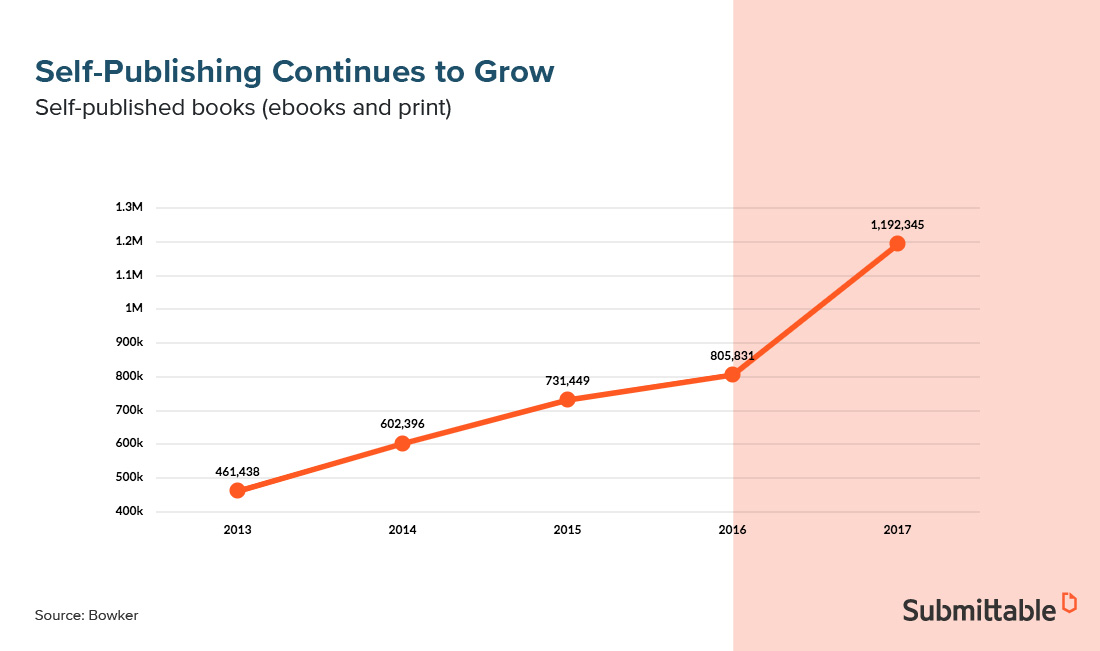
This route can be especially alluring for those who already have a following online and are looking to leverage that audience to publish and sell their own books.
Self-publishing may pose a long-term threat to traditional publishing models as social media enables 1-to-1 communication (and sales) at scale. But it may also herald opportunities for growth.
What this trend means for publishers
While there have been a lot of works that are self-published, there isn’t a clear data to indicate that those titles have eaten into the units sold by imprints. Instead, self-publishing may be opening up new markets and untapped audiences.
This offers an opportunity for publishers.
First, there seems to be a surplus of writers hungry for the opportunity to produce and sell their work, online and in print. As a strategy, firms can improve operations and become more efficient and effective at reaching, soliciting, and selecting works for press.
It’s unlikely that traditional publishers will be able to back the millions of titles that will be published independently within the next few years. But there’s definitely no shortage of work to see and evaluate.
Secondly, the self-publishing model could shift some of the financial risks away from imprints as authors test new titles and markets. In this way, the self-publishing revolution could actually be a boon for publishers, allowing them to hand-select works based on data-driven success metrics, versus the traditional model that involves heavy speculation and risky investments.
We’ve already seen this model play out with the release of Fifty Shades of Grey. The first title in the now-trilogy was a self-published fan fiction piece. But, with its booming success, Vintage came calling. Since then, the Fifty Shades universe has exploded.
In a way, this trend feels poetic.
Self-publishing—championed to circumvent the persistent formality of the traditional publishing industry—has become a proving ground for that very system.
But, for publishers, it’s also a wake-up call.
Trends, tastes, consumers, and technology all change our relationship with words and stories. As individuals, we experience that in real-time, often without noticing. But, as a business, there’s an acute need to recognize and react to those changes as they occur.
The trends we see today will dictate which companies succeed tomorrow.
Looking to improve your publishing process? Submittable can help. Connect with us anytime to learn more about our publication submission software.

